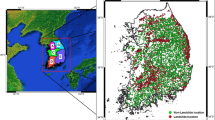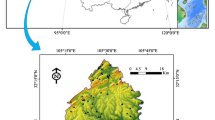Abstract
This paper presents a novel machine learning approach backed by ensembling machine learning algorithms to build landslide susceptibility maps. The results reveal that this approach outperforms prior machine learning-based approaches in terms of precision, recall, and F-score for landslide susceptibility modeling. In this research, three ensemble machine learning algorithms were tested for their applicability in landslide prediction domain, namely, random forest, rotation forest, and XGBoost. A comparison between these ensemble models and the machine learning algorithms used in previous researches was also performed. In order to evaluate the model’s ability to generalize results, two different study areas were used in this study, which are Ratnapura district in Sri Lanka and Glenmalure in Ireland. Several landslide conditioning features including land use, landform, vegetation index, elevation, overburden, aspect, curvature, catchment area, drainage density, distance to water streams, soil, bedrock condition, lithology and rainfall prepared by surveying, remote sensing, and deriving from Digital Elevation Model (DEM) were utilized in building the spatial database. Importantly, this study introduces new landslide conditioning factors like overburden and water catchment areas which have good importance values. Further, research applies dynamic factors like rainfall and vegetation index for susceptibility map building, by making use of remote sensing data which is updated periodically. The study emphasizes the capability of ensemble approaches in generalizing results well for both study areas which inherit completely different environmental properties, and its ability to provide a scalable map building mechanism. Also, useful insights and guidelines are also provided for fellow researchers who are interested in building susceptibility maps using machine learning approaches.
Access this chapter
Tax calculation will be finalised at checkout
Purchases are for personal use only
Similar content being viewed by others
References
Karunaratne, M. (2017). Sri Lanka floods and landslides (p. 2017). Colombo: IOM Sri Lanka.
U. W. L. Chandradasa, Mallawatantri, A., & Wijethunga, R. (2009). Sri Lanka national report on disaster risk, poverty and human development relationship. Ministry of Disaster Management and Human Rights, Sri Lanka.
Subhashini, L. D. C. S., & Premaratne, H. L. (2013). Landslide prediction using artificial neural networks. In ICSBE-2012: International Conference on Sustainable Built Environment, Kandy, Sri Lanka.
Pham, B. T., Bui, D. T., Pourghasemi, H. R., Indra, P., & Dholakia, M. B. (2015). Landslide susceptibility assessment in the Uttarakhand area (India) using GIS: a comparison study of prediction capability of naïve bayes.
Pradhan, B., & Lee, S. (2009). Landslide risk analysis using artificial neural network model focusing on different training sites. International Journal Physics Sciences, 3(11), 1–15.
Hong, H., Liu, J., Bui, D. T., Pradhan, B., Acharya, T. D., Pham, B. T., et al. (2017). Landslide susceptibility mapping using J48 Decision Tree with AdaBoost, Bagging and Rotation Forest ensembles in the Guangchang area (China).
Chen, H., Tang, H. &, Zeng, Z. (2013). Landslide deformation prediction based on recurrent neural network. In International Conference on Neural Information Processing, China.
Oh, H.-J. & Lee, S. (2017). Shallow Landslide susceptibility modeling using the data mining models artificial neural network and boosted tree.
NBRO. (2018). Sri Lankan government research and development institute web resource http://nbro.gov.lk/index.php?lang=en.
Dept. of Geology | SIU. (2018). Geology.Siu.Edu. https://geology.siu.edu/?gclid=EAIaIQobChMIt-bv7sG84wIV1YRwCh2zqQXCEAAYASAAEgIlGPD_BwE.
Chawla, N. V., Bowyer, K. W., Hall, L. O., & Kegelmeyer, W. P. (2002). SMOTE: Synthetic minority over-sampling technique. JAIR, 16, 321–357.
Chung, C.-J. F. & Fabbri, A. G. (1999). Probabilistic prediction models for landslide hazard mapping.
Ward, T. J., Li, R.-M., & Simons, D. B. Mathematical modeling approach for delineating landslide hazards in watersheds.
Hong, Y., Adler, R. F., Huffman, G. (2007). An experimental global prediction system for rainfall-triggered landslides using satellite remote sensing and geospatial datasets. IEEE Transactions on Geoscience and Remote Sensing, 45(6), 1671–1680.
Chang, K., Liu, J., Kuo, C., Wang, H., & Chang, Y. (2017). Combining multi-temporal satellite images and a cloud platform to develop new evaluating procedures for landslide vulnerability study. In 2017 IEEE International Geoscience and Remote Sensing Symposium (IGARSS), Fort Worth, TX, pp. 1912–1915.
Wu, A., Zeng, Z., & Fu, C. (2014). Data mining paradigm based on functional networks with applications in landslide prediction. In 2014 International Joint Conference on Neural Networks (IJCNN), Beijing, pp. 2826–2830.
Chaturvedi, P., Srivastava, S., & Tyagi, N. (2015) Prediction of landslide deformation using back-propagation neural network. In IEEE Workshop on Computational Intelligence: Theories, Applications and Future Directions, India.
Sa, R., Uzirb, N., Rb, S., & Banerjeeb, S. (2016). Experimenting XGBoost algorithm for prediction and classification of different datasets 9(40).
Chen T., & Guestrin C. (2016). XGBoost: A scalable tree boosting system. In Proceedings of the 22nd ACM SIGKDD International Conference on Knowledge Discovery and Data Mining, California, USA, pp. 785–794.
Rodrı´guez, J. J.& Kuncheva, L. I. (2006). Rotation forest: A new classifier ensemble method.
Chen, S. F. & Hsiung, P. A (2017). Landslide prediction with model switching. In The 2018 IEEE Conference on Dependable and Secure Computing, Taiwan.
Bui, D. T, Tuan, T. A., Klempe, H., Pradhan, B., & Revhaug, I. (2016). Spatial prediction models for shallow landslide hazards: A comparative assessment of the efficacy of support vector machines, artificial neural networks, kernel logistic regression, and logistic model tree. Landslides 9, 11, 27 January 2015.
Chen, W., Xie, X., Wang, J., Pradhan, B., Hong, H., Bui, D.T., et al. (2017). A comparative study of logistic model tree, random forest, and classification and regression tree models for spatial prediction of landslide susceptibility. CATENA, 151, 147–160.
Devi, S. R., Venkatesh, C., Agarwal, P. & Arulmozhivarman, P. (2014). Daily rainfall forecasting using artificial neural networks for early warning of landslides. In 2014 International Conference on Advances in Computing, Communications and Informatics (ICACCI) (pp. 2218–2224). IEEE, September, 2014.
United States Geological Survey. (2018). A scientific agency of the United States government, web resource https://earthexplorer.usgs.gov/.
Matsushita, B., Yang, W., Chen, J., Onda, Y. & Qiu, G. (2007). Sensitivity of the enhanced vegetation index (EVI) and normalized difference vegetation index (NDVI) to topographic effects: A case study in high-density cypress forest.
Dark Sky. (2018). web resource https://darksky.net/dev.
Bhunia, G. S., Shit, P. K., & Maiti R. (2016). Comparison of GIS-based interpolation methods for spatial distribution of soil organic carbon (SOC). Journal of the Saudi Society of Agricultural Sciences (in press). http://dx.doi.org/10.1016/j.jssas.2016.02.001
Acknowledgements
Authors are thankful to Director, National Building Research Organization—Sri Lanka (NBRO) for their support for providing required spatial maps for the study area.
Author information
Authors and Affiliations
Corresponding author
Editor information
Editors and Affiliations
Rights and permissions
Copyright information
© 2020 Springer Nature Singapore Pte Ltd.
About this paper
Cite this paper
Bandara, A., Hettiarachchi, Y., Hettiarachchi, K., Munasinghe, S., Wijesinghe, I., Thayasivam, U. (2020). A Generalized Ensemble Machine Learning Approach for Landslide Susceptibility Modeling. In: Sharma, N., Chakrabarti, A., Balas, V. (eds) Data Management, Analytics and Innovation. Advances in Intelligent Systems and Computing, vol 1016. Springer, Singapore. https://doi.org/10.1007/978-981-13-9364-8_6
Download citation
DOI: https://doi.org/10.1007/978-981-13-9364-8_6
Published:
Publisher Name: Springer, Singapore
Print ISBN: 978-981-13-9363-1
Online ISBN: 978-981-13-9364-8
eBook Packages: EngineeringEngineering (R0)




